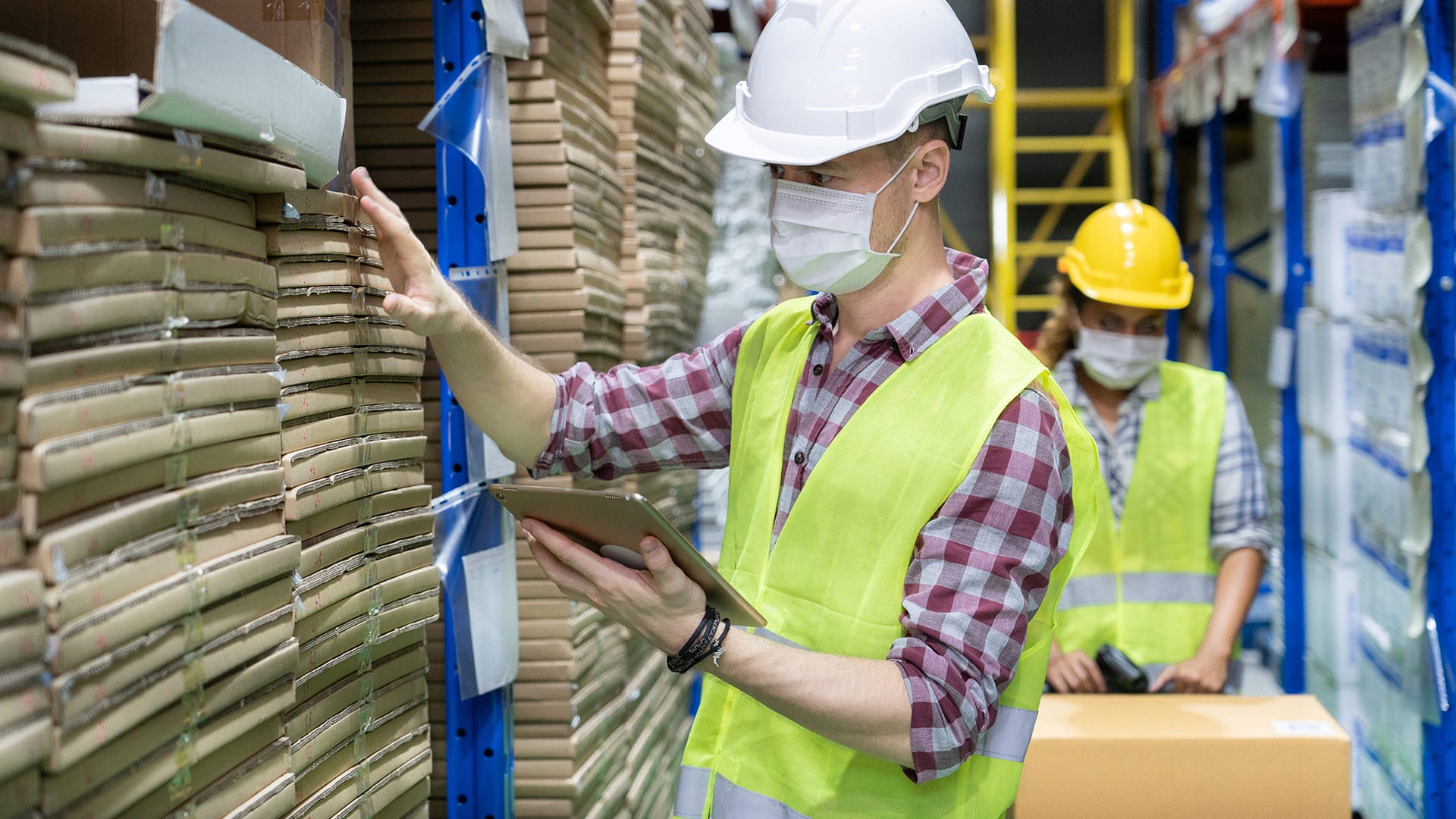
The effects of COVID-19 have been both a wakeup call and a reminder of just how interconnected the world of materials really is. As efficient and positive as this connectedness is, it also comes with built-in vulnerabilities. There is hardly any supply stream that is not affected by what is happening elsewhere in the world. Construction supply chain issues span a wide spectrum of potential disruptions, including the everyday manufacturing and delivery hiccups, to much more specific impacts related to the COVID-19 pandemic.
Regarding COVID-19, we have seen – and continue to see – international impacts; we knew this could happen. We have also seen domestic supply chain disruptions related to government shutdowns or other decisions made to protect workers right here in the US. Not as many saw that coming.
At AXA XL, we wanted to get a handle on the concerns that keep our insureds up at night, so we conducted a COVID-19 impact survey that included questions related to supply chain impacts. According to that research, over 75% of our insureds are more concerned or much more concerned about supply chain and material delivery impacts and their effects on their subcontractors’ ability to perform on their projects. The survey also revealed a similar spike in concern about enterprise approaches to supply chain risk overall. While we hate for anyone to lose sleep, the concerns seem entirely appropriate, and addressing them head-on is the best approach.
With those concerns in mind, let’s nail down some strategies in the form of actions you can take, now and in the future, to develop resiliency in your supply chains and hedge against future impacts.
1. Put someone in charge of the effort. This may be an individual or a committee. The supply chain is a complex subject, and someone needs to own it to achieve success. This person or team needs a broad view of your various supply chain exposures and the ability to make decisions that will help leverage that view across the organization. The primary function of the role should be to break down silos and talk about supply chain risk on an enterprise basis.
2. Create a clear and consistent way to communicate with your subcontractors about supply chain issues. Your subcontractors are closest to the risks and can give you the best possible intelligence; understanding their point of view is critical to getting your approach right. What might such a communication plan include? It varies, but the common themes are consistent.
Talk to your subs about:
3. Conduct a supply chain audit for all projects to develop your first focus. Dig in to understand which materials are truly single source or specialized and what alternates may exist, and which subcontractors or suppliers are particularly financially fragile or on your critical path. And remember, supply chain management isn’t just about knowing where materials will come from; it’s about knowing the code to which they will be manufactured, how quality control is being maintained, and how you will get and stay comfortable with that quality. It’s about knowing how materials will get to your site, monitoring that, and understanding any given material’s importance within the context of your project. Asking all these questions will help you decide where to focus first and most intently.
4. Make a plan to mitigate potential impacts. This seems obvious, but I can tell you there is data out there that shows that the head-in-the-sand approach is really popular. Whatever you do, don't conduct an audit, learn some things, and then hope for the best. Some of the approaches you might consider and implement include alternate materials for those with potential for delays or escalation, resequencing work to accommodate delays, and pre-purchase and storage of at-risk materials. Blue sky thinking definitely has a place here. Be collaborative, be creative, and be persistent.
5. Implement a material monitoring and management plan for all at-risk materials. Track these materials from their point of origin to your site with documentation along the way. Once on site, check them in against submittals to ensure you receive correct and sufficient materials. This is an environment in which substitutions might happen. Don’t leave these responsibilities to the subcontractors only; builders need to own this risk and manage it.
6. Document everything. Baseline your project schedules and cost reports so that they accurately reflect the conditions on site at the time the impact arose. This documentation should be a clear snapshot in time of conditions before the impacts hit and will frame and form the basis of any request for time or cost. Be sure these are accurate and clear, and in agreement with other project documents. This will provide a measurement tool for the impacts you may experience. Incorporate material constraints/delays into your project schedule as they are known, so that it always accurately reflects the actual activities on site. Capture the cost impacts distinctly within your cost reports. Use separate cost codes so that the impacts are easy to pull out and identify clearly.
The important thing to realize with these last three is that it will be very easy to get caught up in “emergency management” and just focus on the day to day running of the project. That is normal human nature — dealing with the most urgent, loud situation first — but contemporaneous capture of all impacts will be critically important for a number of reasons, and working to recreate these documents later will not yield the same accurate and thorough results.
7. Consult your lessons learned. Your firm may have experienced a similar situation in the past due to a port closure, strike, bird flu, or other manufacturer or transport issue. What did you do then? Did it get documented? Read about it. Are some of the folks who dealt with it still available to consult? Do so. So many times, we talk about our challenges “later” only to hear someone say, “Yeah, we had that same issue on project XYZ – we ended up doing such and such.” This knowledge could have saved you so much headache if you had known it earlier. Use every tool at your disposal to find and ensure you leverage all past experiences and understand what worked well then and what they wish they had done or done differently.
8. Educate stakeholders. Once you know the potential impacts of any given material, it is important to educate owners and designers. You’re going to “own” the supply chain risk together for the duration of the project. Some of the smartest strategies will have cost associated or require a design compromise. Make sure everyone knows why it makes sense to spend a bit more or change tack, so that the decisions are owned by the whole team. If the project owner ultimately makes a different choice after hearing your recommendation, consider asking them to indemnify you for the risk with contingencies or other appropriate measures.
9. Look forward. Capture the lessons you’re learning now. Do this contemporaneously. Don’t wait until it all seems clear to you; capture every potentially important fact and factor as you go, and then sort it out later with the benefit of hindsight. Don’t count on your memory – you’re probably going to want to forget this situation – and consider it an investment in your future mental health.
Once you’ve got a handle on the present situation, it’s time to formulate some strategies to put your organization in a better position for the future. For this effort, consider the following:
1. Focus on your “Go / No Go” criteria. Understanding supply chain challenges can help you pursue the right projects. Knowing how flexible and accommodating an owner is likely to be on a project matters. To the greatest extent possible, try to:
These last two point out that historical data is only a snapshot in time, and that the current reality will likely require some adjustments. This is work, but it is work well worth doing, and the assessment and revision of historical data should be a formalized and ongoing effort.
2. Collaborate. Implement an ongoing process for projects to communicate with subs and suppliers to understand their supply chain challenges. As things return to normal, or the current situation begins to feel normal, fight the complacency that can come from familiarity and business as usual. Keep this conversation going, starting at the earliest possible stage of bidding and continuing over the life of each project.
3. Talk about supply chain during subcontractors’ qualification analysis. These conversations are so informative and will form the basis of your supply chain approach specific to this sub and this material. The information your sub or supplier can give off the top of their head is information that you might never find out, or even think of asking about, until it is too late. Use the opportunity to identify those with supply chain redundancies and strong supplier relationships and weigh those things in award decision. Ask subs to disclose the value and source of all potential materials as part of their bid and use this information to make reasonable risk management decisions. As part of that conversation and analysis, it is also important to focus on two additional things:
4. Contemplate future supply chain impacts and incorporate them into your Business Continuity Plan. Get prepared for next time! Whether it’s a pandemic, strikes, tariffs, or embargoes, there will be future interruption events, and supply chain impacts are typically close behind. Plan for that as part of your business continuity plan.
With this type of strategic focus, it is possible to mitigate current risks and avoid or soften future impacts, and that is a goal worth working towards.
About AXA XL:
AXA XL, the property, casualty, and specialty risk division of AXA, provides insurance and risk management products and services for mid-sized companies through to multinationals, and reinsurance solutions to insurance companies globally. We partner with those who move the world forward. To learn more, visit www.axaxl.com.

May we collect and use your data?
Learn more about the Third Party Services we use and our Privacy Statement.May we collect and use your data to tailor your experience?
Explore the benefits of a customized experience by managing your privacy settings for this site or visit our Privacy Statement to learn more about your options.